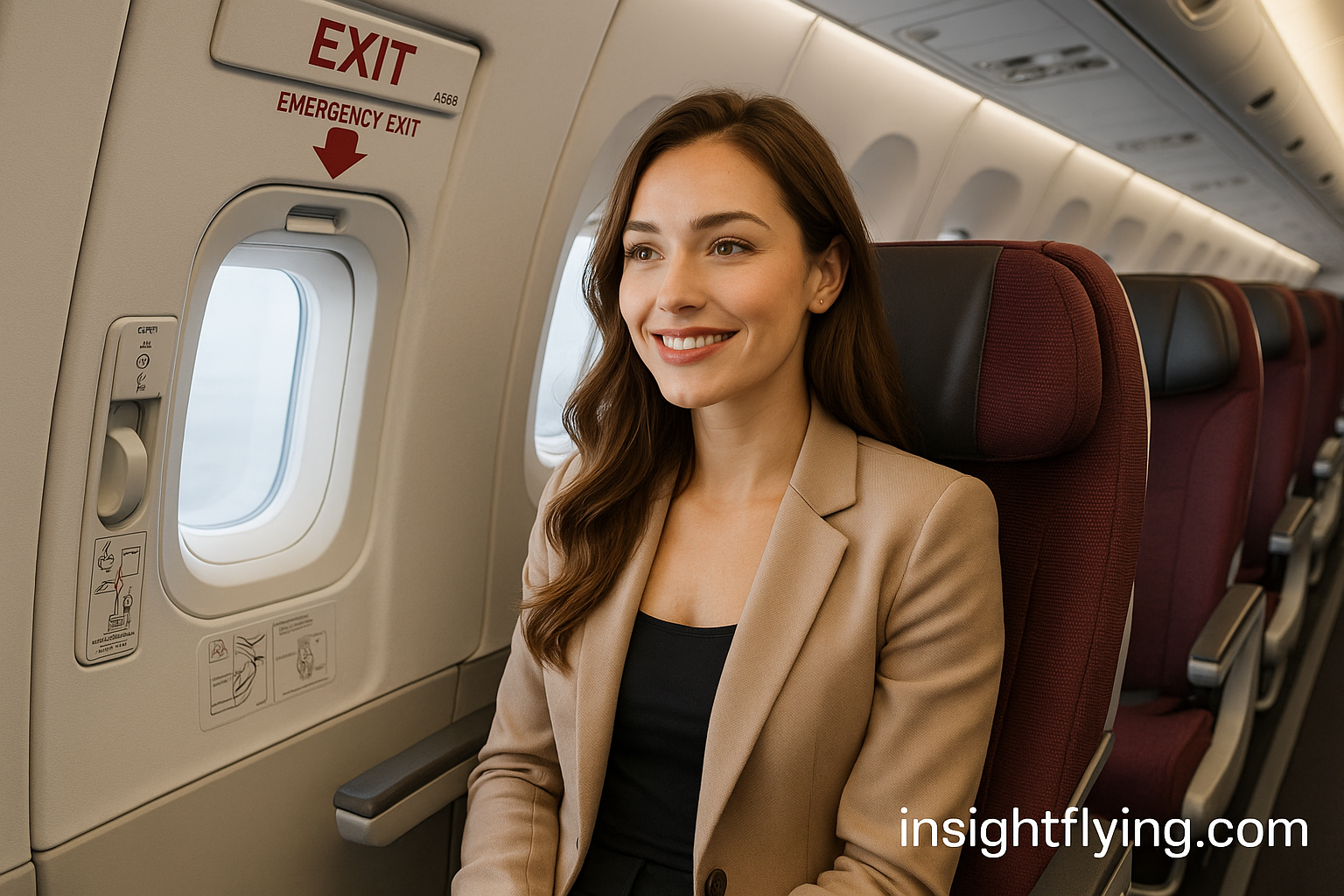ที่นั่งบริเวณทางออกฉุกเฉิน: ความหมาย ข้อจำกัด และกฎระเบียบสำหรับผู้โดยสาร
What is an Emergency Exit Seat?
An Emergency Exit Seat is a passenger seat located next to or near an aircraft’s emergency exit door. These exits are designed to allow rapid evacuation of passengers in the event of an emergency. Seats in these rows are specially designated because passengers seated there may be required to assist the cabin crew in operating the exit and guiding others during an evacuation.
ที่นั่งบริเวณทางออกฉุกเฉิน คือที่นั่งของผู้โดยสารซึ่งอยู่ติดหรือใกล้กับประตูทางออกฉุกเฉินของอากาศยาน โดยทางออกฉุกเฉินถูกออกแบบไว้เพื่อใช้ในการอพยพผู้โดยสารออกจากเครื่องอย่างรวดเร็วเมื่อเกิดเหตุฉุกเฉิน ที่นั่งในแถวนี้จึงมีความสำคัญเป็นพิเศษ เพราะผู้โดยสารที่นั่งในตำแหน่งนี้อาจต้องช่วยลูกเรือในการเปิดประตูและช่วยนำทางผู้โดยสารคนอื่นให้อพยพออกจากเครื่องได้อย่างปลอดภัย
Why Are There Special Rules for These Seats?
The main reason for having specific rules is safety. During an emergency, the exit area must be clear and accessible, and the person occupying the seat must be physically and mentally capable of understanding and performing evacuation duties. Therefore, airlines impose strict regulations on who may sit in these seats.
เหตุผลสำคัญที่ต้องมีกฎเฉพาะสำหรับที่นั่งบริเวณทางออกฉุกเฉินคือ ความปลอดภัย เนื่องจากในสถานการณ์ฉุกเฉิน พื้นที่บริเวณทางออกต้องว่างและพร้อมใช้งานได้ทันที ผู้โดยสารที่นั่งในตำแหน่งนี้จึงต้องมีความสามารถทั้งทางร่างกายและจิตใจในการเข้าใจและปฏิบัติหน้าที่ช่วยเหลือในการอพยพได้อย่างถูกต้อง ดังนั้นสายการบินจึงมีกฎระเบียบที่เข้มงวดในการคัดเลือกผู้ที่สามารถนั่งในตำแหน่งนี้ได้
Passenger Eligibility and Restrictions
Passengers who wish to occupy the emergency exit seat must meet the following general conditions (which may vary slightly among airlines):
- Must be at least 15 years old.
- Must be physically fit and capable of operating the exit without assistance.
- Must be able to understand crew instructions in English or the language used on the flight.
- Must not require special assistance, such as the use of wheelchairs or medical equipment.
- Must not be traveling with infants or young children.
- Must be willing to perform the necessary duties in case of an emergency.
ผู้โดยสารที่ประสงค์จะนั่งบริเวณทางออกฉุกเฉินจะต้องมีคุณสมบัติดังต่อไปนี้ (ซึ่งอาจแตกต่างกันไปตามนโยบายของแต่ละสายการบิน):
- ต้องมีอายุ ไม่น้อยกว่า 15 ปี
- ต้องมีสุขภาพร่างกายแข็งแรง สามารถเปิดประตูฉุกเฉินได้ด้วยตนเอง
- ต้องสามารถ เข้าใจคำสั่งของลูกเรือ ได้ในภาษาอังกฤษหรือภาษาที่ใช้บนเที่ยวบิน
- ต้อง ไม่เป็นผู้โดยสารที่ต้องการความช่วยเหลือเป็นพิเศษ เช่น ใช้รถเข็นหรือมีอุปกรณ์ทางการแพทย์
- ต้อง ไม่เดินทางพร้อมทารกหรือเด็กเล็ก
- ต้องมีความสมัครใจและพร้อมจะปฏิบัติหน้าที่ตามที่ลูกเรือร้องขอเมื่อเกิดเหตุฉุกเฉิน
What Passengers Must Do When Seated There
Before departure, the cabin crew will provide a special briefing for passengers seated at the emergency exit row. They must read the safety information card, listen carefully to instructions, and confirm that they understand the procedures for operating the exit door.
ก่อนออกเดินทาง ลูกเรือจะให้คำชี้แจงเป็นพิเศษแก่ผู้โดยสารที่นั่งในแถวทางออกฉุกเฉิน ผู้โดยสารต้องอ่านบัตรข้อมูลความปลอดภัยอย่างละเอียด รับฟังคำอธิบายจากลูกเรือ และยืนยันว่าตนเข้าใจวิธีการเปิดประตูและขั้นตอนการอพยพในกรณีฉุกเฉิน
Why Passengers May Be Reassigned
If a passenger seated in the emergency exit row does not meet the safety criteria, the cabin crew has the authority to reassign the seat before takeoff. This ensures compliance with safety regulations and protects all passengers onboard.
หากผู้โดยสารที่นั่งบริเวณทางออกฉุกเฉินไม่เป็นไปตามคุณสมบัติด้านความปลอดภัย ลูกเรือมีสิทธิ์เปลี่ยนที่นั่งให้ก่อนเครื่องออก เพื่อให้เป็นไปตามข้อกำหนดด้านความปลอดภัยและเพื่อความปลอดภัยของผู้โดยสารทุกคนบนเครื่อง
In Summary
The Emergency Exit Seat offers extra legroom, but it comes with responsibility. Occupying this seat means you play a vital role in ensuring the safety of everyone on board. Always cooperate with the cabin crew and be prepared to assist if the situation arises.
โดยสรุป ที่นั่งบริเวณทางออกฉุกเฉินแม้จะมีพื้นที่วางขามากกว่า แต่ก็มาพร้อมกับความรับผิดชอบ ผู้โดยสารที่นั่งในตำแหน่งนี้มีบทบาทสำคัญในการช่วยรักษาความปลอดภัยของทุกคนบนเครื่องบิน จึงควรให้ความร่วมมือกับลูกเรือและเตรียมพร้อมช่วยเหลือเมื่อเกิดเหตุฉุกเฉิน
